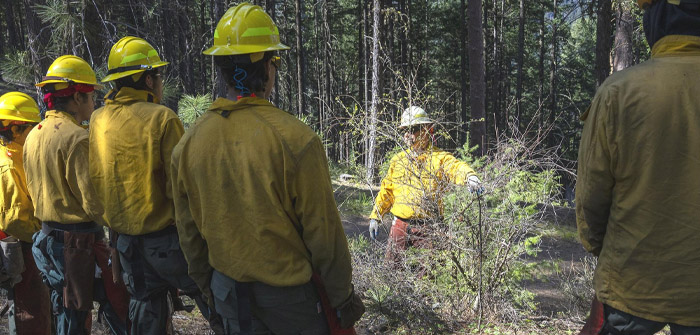(Ryan Puckett, Restoration Technician Manager, for the Lomakatsi Restoration program, instructs the tribal crew members on what trees they will be working on during a day in the field | USDA Forest Service photo by Preston Keres)
At sunrise in the beautiful lands of the Rogue River-Siskiyou National Forest in Ashland, Oregon, a group of tribal youth gather to begin a busy day of outdoor projects in their ancestral homelands. The Rogue River-Siskiyou National Forest is working collaboratively with partners such as Lomakatsi Restoration Project, a nonprofit organization with a long history of partnering with the Forest Service across Oregon and northern California to provide ecological forestry workforce training programs and help lead community watershed restoration projects.
(Inter-tribal crew members in Lomakatsi’s Tribal Youth Ecological Forestry Training Program conduct ecological thinning within the Ashland Forest Resiliency Stewardship Project, near Ashland, Oregon | USDA Forest Service video by Preston Keres)
Working through Lomakatsi’s Tribal Youth Ecological Forestry Training Program, the inter-tribal crew is comprised of enrolled members of the neighboring Klamath Tribes, Pit River Tribe, and Fort Bidwell Paiute Tribe. During the year-long program, tribal youth ages 18 to 30 years old are paid to train and earn professional certifications that support careers in conservation, ecological restoration, cultural resource management and wildland fire. Field activities include ecological thinning using chainsaws, learning how to collect forestry data, digging fire lines for a future prescribed burn and earning their certification in cultural resource monitoring.
“The work we do at Lomakatsi is nurturing the spirit of our tribal youth while providing them with the outdoor experience to reconnect with the lands of our ancestors.” said, Belinda Brown, Tribal Partnerships Director of Lomakatsi.
At the end of the program the youth know that they will carry on the lessons they learned and the connections they made throughout the program for the rest of their lives.
Looking to the future
Ryan Puckett, Restoration Technician Manager for the Lomakatsi Restoration program, said, “There isn’t a manual on doing forestry on the ground. Ninety-five percent of our youth crew have a background of the local woods as part of their way of life. We work with the youth in teaching them empowerment and confidence to learn the needed tools to be successful. What better way than to have the local Indigenous peoples be the current and future caretakers.”
Native American people have been using Indigenous knowledge for hundreds of years, including traditional activities such as hunting, gathering and cultural burning. Learning and honoring the Native American cultures and traditions is the key to navigating the changes of climate, ecology and forest management we face today.
According to Brown, “Many forests and watersheds throughout the West are highly degraded following colonization and the removal of indigenous peoples as the first, best stewards of the land. At the request of tribal partners, we are bringing our workforce training programs to serve tribal youth and accomplish important ecological restoration treatments across ancestral lands, including National Forest System and tribal lands.”
Decades of fire suppression on the Rogue River-Siskiyou National Forest have led to overly dense forests that place the forest at very high risk of severe wildfire — threatening the ecosystem and nearby communities.
“What we are doing is preparing the landscape for beneficial fire,” said Lomakatsi Executive Director Marko Bey. “These tribal young adults are learning the best practices of the entire ecological restoration process — how to safely use chainsaws to thin smaller, younger trees and protect the large, old trees that are the ecological anchors of the forest, and how to apply prescribed fire.”
According to some of the tribal youth, Nahayah Harris says, “Our work is important. As a tribal woman it feels good to be out here [in the forest]like my ancestors were and not stuck behind a desk just because I’m a woman.”
Seneca Hescock, says, “As a tribal member, the work we do is empowering. Because there’s not a lot of tribal members doing the work we do.” And Richard Hamilton says, “The work is like a rush. Never know how the day will go.”
Relationships between the Forest Service and Lomakatsi provide a ray of hope for the next generation of youth like Nahayah, Seneca and Richard, who look to make a difference, whether it be working for a federal agency, tribe, or nonprofit.
History of Lomakatsi Restoration Project
The Rogue-River Siskiyou National Forest has had a long-standing relationship with Lomakatsi that spans decades as one of the earliest federal partners. In 2018, when Merv George, a member of the Hoopa Valley Tribe, became the first Native American Forest Supervisor for the Rogue River-Siskiyou National Forest, he further inspired the local community to honor and respect the tribal culture and practices of forest restoration.
Through his vision and advocacy, George helped secure substantial investments for tribally centered collaboration and workforce development, including through the five-year Inter-Tribal Forestry Workforce Development Initiative co-developed with Lomakatsi through the Collaborative Forest Landscape Restoration Program.
Since then, the Lomakatsi model was largely refined on the Rogue River-Siskiyou National Forest, where the Forest Service, and other partners have been working collaboratively for over 15 years to restore federal and adjacent municipal and private lands.
Today, George is the Deputy Regional Forester for the Pacific Northwest Region, where he continues to champion and inspire tribal partnerships and work to protect local communities and vulnerable populations.
“Because of climate change and increasing fire severity, we are all hands-on-deck when it comes to tackling the wildfire issue,” says Bey. “This work prepares the landscape so when fire does come through, it is more likely to burn at a lower severity and bring benefits to the land.
This year, Lomakatsi and the Forest Service Pacific Southwest Region and Pacific Northwest Region launched an inter-regional Indian Youth Service Corps agreement that will result in Lomakatsi expanding the program across California, Oregon, and Washington states to serve six additional National Forests.
This equips Lomakatsi to provide a Public Land Corps Hiring Certificate to participants who complete at least 640 hours of their programs, giving employment preference for tribal young adults and supporting pathways to federal natural resource careers.
Youth programs like these are essential to building the workforce of tomorrow and serve as a regional model for incorporating Indigenous knowledge into landscape restoration efforts, providing both economic benefits and inspiration for natural resource careers.
To learn more about the Indian Youth Service Corp, click here.



